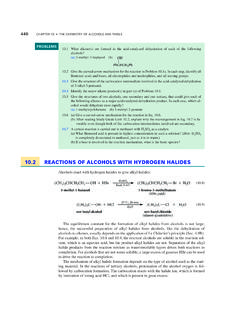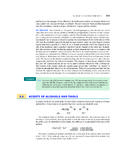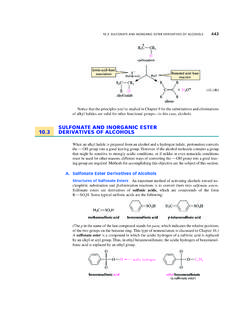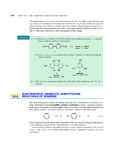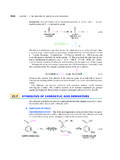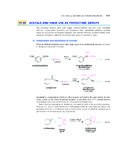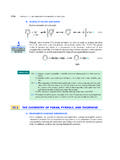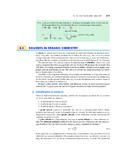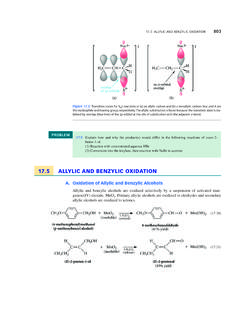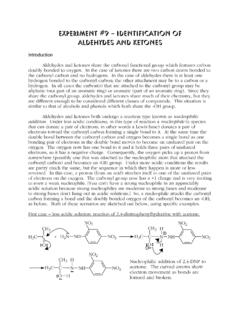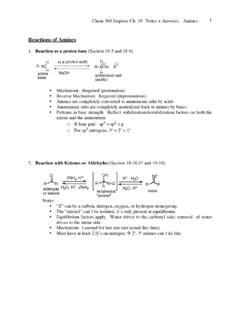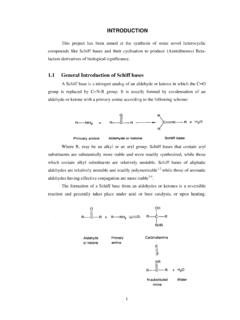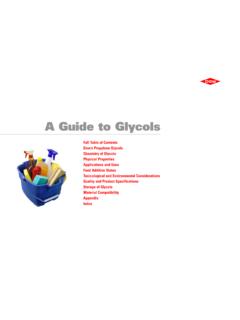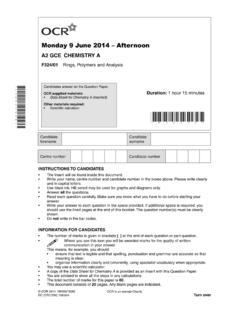Transcription of 926 CHAPTER 19 • THE CHEMISTRY OF ALDEHYDES AND …
1 926 CHAPTER 19 THE CHEMISTRY OF ALDEHYDES AND KETONES. carbonyl -ADDITION REACTIONSN otice in this synthesis that all steps following acetal formation involve basic or neutral condi-tions. Acid can be used only when destruction of the acetal is any acetal group can in principle be used, the five-membered cyclic acetal is fre-quently employed as a protecting group because it forms very rapidly (proximity effect; Sec. )and it introduces relatively little steric congestion into the protected number of reagents that react with carbonyl groups also react with other functionalgroups.
2 Acetals are commonly used to protect the carbonyl groups of ALDEHYDES and ketonesfrom basic, nucleophilic reagents. Once the protection is no longer needed, the acetal protect-ing group is easily removed, and the carbonyl group re-exposed, by treatment with diluteaqueous acid. Because acetals are unstable in acid, they do notprotect carbonyl groups underacidic a synthesis of the following compound from p-bromoacetophenone and any OF ALDEHYDES AND KETONES WITH AMINESA. Reaction with Primary Amines and Other Monosubstituted Derivatives of AmmoniaA primary amineis an organic derivative of ammonia in which only one ammonia hydrogenis replaced by an alkyl or aryl group.
3 An imineis a nitrogen analog of an aldehyde or ketonein which the CAO group is replaced by a CANR group, where R=alkyl, aryl, or ( )LcLLSCH3 COBracetal protecting group;inert to Grignard reagentsBrBrMgMgintroduction of thethe protecting groupformation of theGrignard reagentprotonolysis of the alkoxideand hydrolysis of the acetal(removal of the protecting group)LOH2 CCH2$$BrMg|_OCH2CH2H2O, H3O|etherHOCH2CH2 OHLcLLSCH3 COHOCH2CH2+HOCH2CH2 OHp-toluenesulfonicacid (trace)(See Eq. ) 12/9/08 11:41 AM Page reactions OF ALDEHYDES AND KETONES WITH AMINES927(Imines are sometimes called Schiff basesor Schiff s bases.)
4 Imines are prepared by the re-action of ALDEHYDES or ketones with primary of imines is reversible and generally takes place with acid or base catalysis orwith heat. Imine formation is typically driven to completion by precipitation of the imine, re-moval of water, or mechanism of imine formation begins as a nucleophilic addition to the carbonyl this case, the nucleophile is the amine, which reacts with the aldehyde or ketone to give anunstable addition product called a carbinolamine. A carbinolamineis a compound with anamine group (LNH2, LNHR, or LNR2) and a hydroxy group on the same carbon.
5 (You should write the detailed mechanism, which is analogous to the mechanism of other re-versible additions .) Carbinolamines are not isolated, but undergo acid-catalyzed dehydrationto form imines. This reaction is essentially an alcohol dehydration (Sec. ), except that it istypically much faster than dehydration of an ordinary alcohol.(Write the mechanism of this reaction as well.)Typically, the dehydration of the carbinolamine is the rate-limiting step of imine is why imine formation is catalyzed by acids.
6 Yet the acid concentration cannot be toohigh because amines are basic compounds, and because protonated amines cannot act as of the amine pulls the equilibrium in Eq. to the left; consequently, if theacid concentration is high enough, carbinolamine formation cannot occur. For this reason,many imine syntheses are carried out in very dilute summarize: Imine formation is a sequence of two reactions that have close analogies tofamiliar reactions namely, carbonyl additionfollowed by use of imines is in the preparation of amines; this is discussed in Sec.
7 Anotheruse, which was more important before the advent of spectroscopy than it is now, is in the char-acterization of ALDEHYDES and ketones. When a new compound was synthesized, it was typically( )+RNH22H3O|2+RNH3|3H2O2( )H2 OLLCOH carbinolamineimineNRH+"""2NR2acidAC$)( )3LH2 NRLRLLCOH carbinolamineNH+""S%%CO2( )cLLOCHcLCHPha primaryaminean imine(84 87% yield)(separates fromthe reactionmixture)PhAA2NH2H2OL2N++heat2 LRprimary amineNH2A22 OCaldehyde or ketone $)Limine2 NRAC$)STUDY GUIDE LINK ofCarbinolamineFormationSTUDY GUIDE LINK 12/9/08 11:41 AM Page 927928 CHAPTER 19 THE CHEMISTRY OF ALDEHYDES AND KETONES.
8 carbonyl -ADDITION reactions characterized by conversion into two or more crystalline compounds called served as the basis for subsequent identification of the new compound when it wasisolated from another source or from a different reaction. It was important to prepare derivativesbecause they eliminated the ambiguity that could arise if two compounds have very similarmelting points or boiling points. It is relatively improbable that two compounds with the samemelting or boiling points will give two crystalline derivatives with the same melting imines are frequently used as solid derivatives of ALDEHYDES and ketones.
9 Theseimines, and the amines from which they are derived, are listed in Table For example, the2,4-DNP derivative of acetone is prepared by formation of an imine with 2,4-dintrophenylhydrazine:To illustrate how such derivatives might be used in structure verification, suppose that achemist has isolated a liquid that could be either 6-methyl-2-cyclohexenone or 2-methyl-2-cy-clohexenone. The boiling points of these compounds are too similar for an unambiguous iden-tification.
10 Yet the melting point of either a 2,4-DNP derivative or a semicarbazone (see ) would quickly establish which compound has been 69 71 C (18 mm)177 178 C162 164 CCH3 MOS 69 70 C (16 mm)207 208 C207 208 Cboiling pointsemicarbazone, mp2,4-DNP derivative, mp( )++dilute H2SO4C2H5 OHH2 OCH3 LLH3 CCOSCH3 LLH3 CCScNHLLLNO2NO2LN22(precipitates)a 2,4-dinitrophenylhydrazone(2,4-DNP derivative of acetone)cNHLLLNO2NO2LH2N222,4-dinitrophe nylhydrazine(2,4-DNP)Some N-Substituted Imine Derivatives of ALDEHYDES and KetonesAmineNameCarbonyl DerivativeNamehydroxylamineoximehydrazin ehydrazonephenylhydrazinephenylhydrazone semicarbazidesemicarbazoneNH22 NHLLCO2SA2LR2 CNLH2N2NH22 NHLLCO2S2,4-dinitrophenylhydrazone(2,4-D NP derivative)LcLNO2NO2$A2LR2 CNNH22,4-dinitrophenylhydrazine(2,4-DNP) LLcLH2 NNO2NO22NH2$LcA2LR2 CNNH2 LLcH2N2NH2A2LR2 CNNH22LH2N2NH2222 OHA2LR2 CNLH2N2OH22 TABLE 12/9/08 11.

